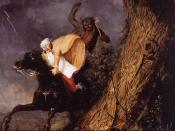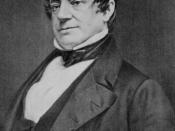In Washington Irving's short story "The Devil and Tom Walker", the author depicts the main character as a very stereotypical character with little individuality. Tom's actions are easily predicted and his eventual downfall is used to illustrate the story's moral.
Tom Walker is a very typical one-dimensional character. He is purely evil with not a bit of goodness. From the very beginning of the story, the reader is shown that he is a lying, cheating, conniving miser who cares for no one (not even his own wife) but himself. He does his best to cheat his wife out of money and things that should be common property in a marriage. When his wife disappears (presumably she has been killed by the Devil), he is not concerned in the least for her well-being. Instead he joyfully snatches her apron down from a tree, supposing it to contain the household valuables.
When Tom opens the apron and finds a heart and liver, he is not horrified as most people would be if they discovered that their spouse had been slain; rather, he is saddened that his property is lost and overjoyed that the Devil has done him the favor of getting rid of his wife. Only the most purely evil person would feel this way.
Tom Walker's actions are predictable because he's a simple-minded greedy man. He's very one-dimensional; he represents the greed that inherent to human nature, but he is totally consumed by it. The reader can assume that because Tom is so greedy, he will eventually sell his soul to the Devil in exchange for riches--and so he does. Also, because this type of story (man meets devil, man sells his soul to devil, man suffers dire consequences in the end) is quite typical, it is easy...


